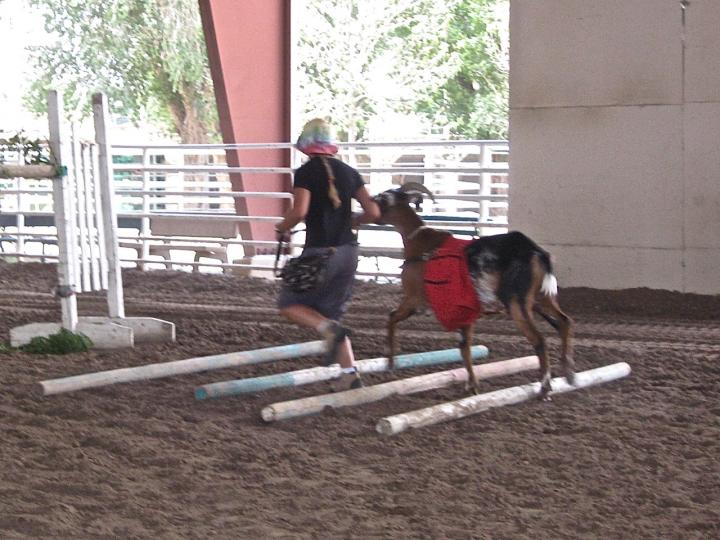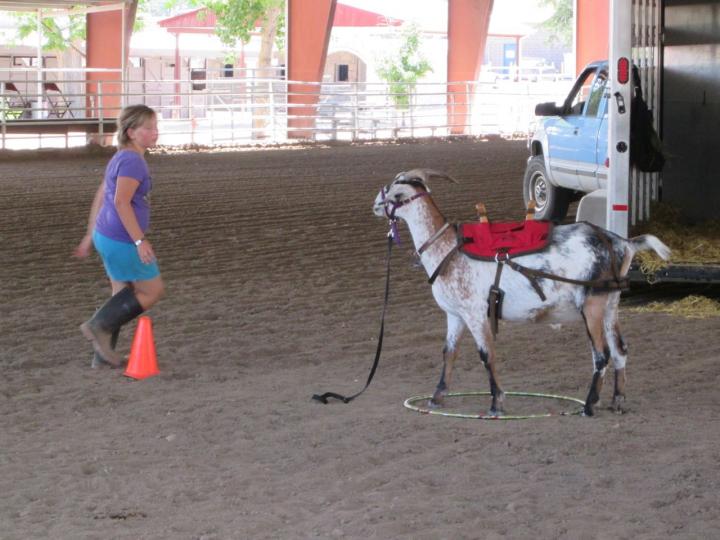08-15-2016, 03:16 PM
Jump (easy to difficult):
This obstacle is fun because the difficulty can be chosen by the handler. I like to set one end of the jump at 2' 6" - 2' 9". The other end sets at ground level or up to 6". The handler chooses which part of the jump to cross. More points are awarded depending on how high the goat jumps. Points are deducted for balking or hitting the jump. No points are awarded if the goat knocks the jump down.

Trot Obstacle (moderate):
This practical demonstration obstacle can be set up any number of ways. It may have trot-over poles evenly spaced apart, weave poles/cones, or just a straight distance from one cone to another. If you are setting up this obstacle, make sure to leave plenty of distance to demonstrate a nice trot. This obstacle is often not given enough space. If using weave poles/cones, make sure they are set far enough apart that a big goat can successfully negotiate them at a trot. High score goes to goats who trot willingly on command without being dragged or struck from behind with the leash.

Narrow Bridge (moderate):
A narrow bridge can be set directly on the ground or elevated above it using a 2" x 12" board about 12 feet long. Above-ground bridges are psychologically easier for the goat but must be safely constructed and not too high (I heard about one that was 5' off the ground and a goat fell off it!). Straw bales, cinder blocks, and log rounds all make good end supports. The board should be supported in the middle so a heavy goat can't crack it. If a suitable board isn't available, this obstacle can be set up using two 12'-long poles set about 12" apart. The goat must walk between the poles without stepping on them or outside them. Some goats will demonstrate a natural ability to walk on top of one pole for the entire length. While certainly amusing, this is not worth extra points.

Standing Still for Spooks (moderate to difficult):
This obstacle can be presented many different ways. The photo here is of a girl who has put on a raincoat and opened an umbrella while her goat ground ties next to her. The coat was set on one of the cones, and the handler had to walk around the goat with the umbrella opened. This is a difficult obstacle because the goat is required to stand ground tied while the handler walks around him. Simpler obstacles should not require ground tying. Another way to do this would be to have a raincoat or tarp placed in the packsaddle before the start of the course. At some point the handler would have to stop the goat, remove the "scary" item and shake it out/put it on while the goat stands. You can also have a handler remove and then replace a packsaddle, throw a tarp or blanket over a goat, etc. The main objective is to demonstrate that the goat will stand still and not spook at the item that is being presented.

Ground tie (difficult):
This is one of the more practical demonstrations on an obstacle course. It shows that the goat has been worked extensively at home and is obedient to the "whoa" command when not restrained. I have had contestants park their goats near a cone at most shows, but the inconspicuous nature of a single cone meant that the obstacle was often overlooked. So for the last show I used a hula hoop which worked very well as a visual aid. Handlers had to park their goat's front feet inside the hoop, drop the rope, and walk around the cone. The goat's front feet must remain inside the hoop to get points. Points are deducted if the goat moves or if the handler rushes.

This obstacle is fun because the difficulty can be chosen by the handler. I like to set one end of the jump at 2' 6" - 2' 9". The other end sets at ground level or up to 6". The handler chooses which part of the jump to cross. More points are awarded depending on how high the goat jumps. Points are deducted for balking or hitting the jump. No points are awarded if the goat knocks the jump down.

Trot Obstacle (moderate):
This practical demonstration obstacle can be set up any number of ways. It may have trot-over poles evenly spaced apart, weave poles/cones, or just a straight distance from one cone to another. If you are setting up this obstacle, make sure to leave plenty of distance to demonstrate a nice trot. This obstacle is often not given enough space. If using weave poles/cones, make sure they are set far enough apart that a big goat can successfully negotiate them at a trot. High score goes to goats who trot willingly on command without being dragged or struck from behind with the leash.

Narrow Bridge (moderate):
A narrow bridge can be set directly on the ground or elevated above it using a 2" x 12" board about 12 feet long. Above-ground bridges are psychologically easier for the goat but must be safely constructed and not too high (I heard about one that was 5' off the ground and a goat fell off it!). Straw bales, cinder blocks, and log rounds all make good end supports. The board should be supported in the middle so a heavy goat can't crack it. If a suitable board isn't available, this obstacle can be set up using two 12'-long poles set about 12" apart. The goat must walk between the poles without stepping on them or outside them. Some goats will demonstrate a natural ability to walk on top of one pole for the entire length. While certainly amusing, this is not worth extra points.

Standing Still for Spooks (moderate to difficult):
This obstacle can be presented many different ways. The photo here is of a girl who has put on a raincoat and opened an umbrella while her goat ground ties next to her. The coat was set on one of the cones, and the handler had to walk around the goat with the umbrella opened. This is a difficult obstacle because the goat is required to stand ground tied while the handler walks around him. Simpler obstacles should not require ground tying. Another way to do this would be to have a raincoat or tarp placed in the packsaddle before the start of the course. At some point the handler would have to stop the goat, remove the "scary" item and shake it out/put it on while the goat stands. You can also have a handler remove and then replace a packsaddle, throw a tarp or blanket over a goat, etc. The main objective is to demonstrate that the goat will stand still and not spook at the item that is being presented.

Ground tie (difficult):
This is one of the more practical demonstrations on an obstacle course. It shows that the goat has been worked extensively at home and is obedient to the "whoa" command when not restrained. I have had contestants park their goats near a cone at most shows, but the inconspicuous nature of a single cone meant that the obstacle was often overlooked. So for the last show I used a hula hoop which worked very well as a visual aid. Handlers had to park their goat's front feet inside the hoop, drop the rope, and walk around the cone. The goat's front feet must remain inside the hoop to get points. Points are deducted if the goat moves or if the handler rushes.





